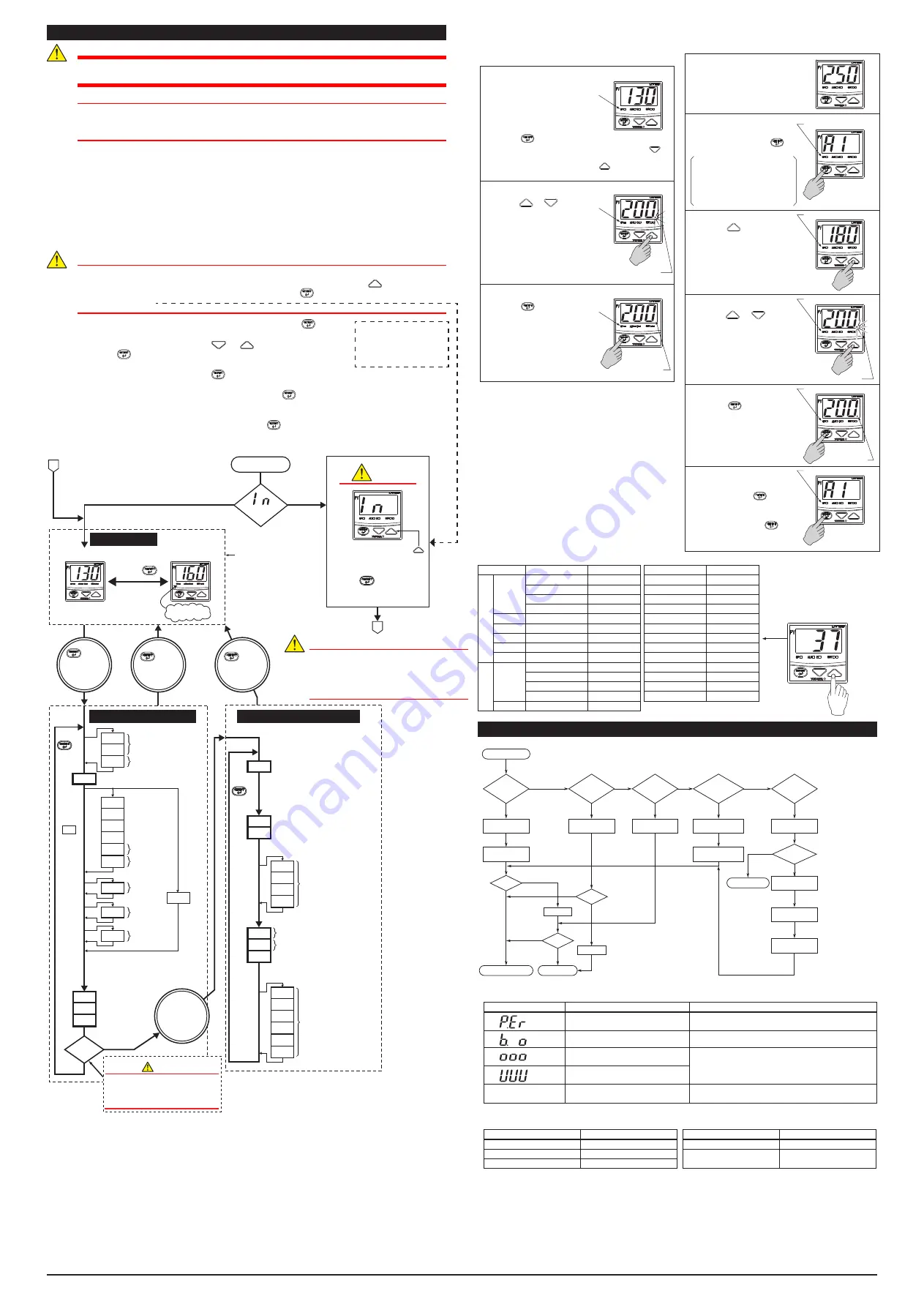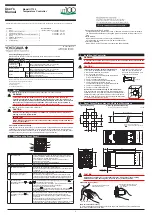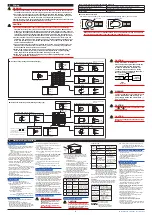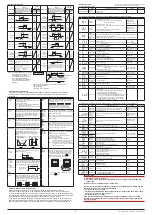
IM 05C01E02-01E 4th Edition Mar. 14, 2016-00
3
7.
Key Operations
WARNING
To prevent electric shock, the controller should be mounted on the panel so that you do
not accidentally touch the terminals when power is being applied.
IMPORTANT
The temperature controller is shipped with the parameters set at the factory-set
defaults. Check the default values against the “Parameter Lists” in the following page,
and change the parameter settings that need to be changed.
This section explains how to set and register parameter values.
The procedure for changing SP (target setpoint) and A1 (alarm 1 setpoint) can be found on
“Changing Target Setpoint (SP)” and “Changing Alarm 1 Setpoint (A1),” respectively. You can set the
other parameters in the same way.
There are no setup displays for parameters specific to functions, such as the optional alarm output
functions or heating/cooling control, if they were not selected at ordering.
The setting of some parameters (such as the control mode parameter CTL) determines whether the
other parameters are displayed or not.
The flowchart below will help you understand how this works.
CAUTION
At power-on, the temperature controller displays the operating display, but if the input
range setting remains OFF, then “IN” appears. In this case, press the
key to display
the input range code you want to use, then press the
key to register it. (Refer to the
flowchart below.)
(1) You can move between parameter setting displays using the
key.
(2) To change the set value,
(i) Change the display value with the
or
key (the period flashes).
(ii) Press the
key to register the setting.
(3) At the operating display, pressing the
key for at least 3 seconds retrieves the operating
parameter setting display.
(4) At the operating parameter setting display, pressing the
key for at least 3 seconds transfers
back to the operating display. Registering the key-lock parameter LOC to “–1” retrieves the setup
parameter setting display.
(5) At the setup parameter setting display, pressing the
key for at least 3 seconds transfers back
to the operating display.
CUATION
Set “-1” to enter the setup parameter setting
display. But if “LOC=1 or 2” is already set, the
parameter value can not be changed by setting
“LOC=-1” only. To change the parameter value,
set “LOC=0” at first (for disabling keylock),
then set “LOC=-1” once again.
Note: If no key is pressed for a period
of two minutes or more while in
the operating or setup parameter
setting display, the controller
automatically returns to operating
display.
Note
Note
Press the
key for
at least 3 seconds.
(To operating
parameter setting
display)
Press the
key for
at least 3 seconds.
(To operating
display)
Press the
key for
at least 3 seconds.
(To operating
display)
Press the
key
to move
between items.
Displayed for the /AL or
/HBA option
Not displayed when CTL=ONF
(on/off control)
Not displayed for heating/cooling type
Displayed for the /RS option
Press the
key
to move
between items.
• Displayed only for the /AL or
/HBA option
• Not displayed when AL1, AL2 = OFF
• Not displayed when AL1,
AL2 = 21 or 22
• Displayed only for the /HBA option
and when AL1 = 25
Displayed when I=OFF
Displayed for heating/
cooling type
Displayed for heating/
cooling type
Note
CTL
=SLF
CTL=PID
CTL=ONF
(on/off
control)
CTL=SLF is not
permitted for
heating/cooling
type.
When LOC=–1,
transfers to the
setup parameter
setting display
LOC=
When
LOC=–1
Displayed for time-
proportional PID control
Displayed for time-
proportional PID control
of heating/cooling type
is displayed
?
Yes
No
When measured input range code has been already set, the
operating display shown below appears.
Displays PV
Displays SP
To switch between PV and
SP, press the key
SP display lamp is on.
SP (target setpoint) can be
changed in the operating display.
When “In” appears, press the
key to display the measured input
range code you want to use, then
press the key to register it.
After this operation, the controller
shows the operating display.
The data (PV or SP) selected in DSP
is displayed at first.
(PID control)
(Dynamic
Auto Tune)
Operating parameter setting display
Setup parameter setting display
CAUTION
Power ON
A
SPH
SPL
SC
DR
DSP
AL1
AL2
HY1
HY2
PSL
ADR
BPS
PRI
STP
DLN
IN
CT
CTC
DB
HYS
A1
A2
HC
FL
BS
LOC
AT
P
I
D
MR
COL
CTL
Operating display
A
Note: If you cannot change
the parameter setting
value, check the
key-lock parameter
(LOC) setting.
CAUTION
Changing certain setup parameters may automatically
initialize the operation parameters. Therefore, after you
change the setup parameters, always check the operation
parameter settings to find out if appropriate values have
been set for them. If the operation parameters have been
initialized, set them to their appropriate values.
The following instructions assume that the
controller is already receiving power.
Step 1:
Confirm that the controller
shows the operating display
during normal operation.
(See note 1)
If the controller displays PV,
press the key once to
display SP (SP display lam
is on).
Step 1:
Confirm that the controller
shows the operating display
during normal operation.
(See note 1)
Step 3:
Press the key once to
display the current A1
value.
The SP display lamp
flashes quickly.
Step 2:
Press the or key to
change the displayed SP
value to the required value. In
this example, SP is changed
to 200°C.
The period flashes while the value is being changed.
Step 2:
To enter the operating parameter
setting display, press the
key for at least 3 seconds.
If your controller has the /AL or
/HBA option, the display for the
Alarm 1 setpoint (A1) appears.
(If not, control mode (CTL)
appears.)
Step 3:
Press the key once
to register the setting.
The period goes out.
SP is now changed.
Note 1: The operating display shows either PV or SP.
You can find out which data is displayed by the
SP display lamp status.
a. OFF: PV display of operating display
b. ON: SP display of operating display
c. Slow flashing: Parameter code is displayed.
d. Quick flashing: Parameter value is being
changed.
The period goes out.
Step 4:
Press the or key to
change the displayed A1
value to the required value.
In this example, A1 is
changed to 200°C.
The period flashes while the value is being changed.
Step 5:
Press the key once
to register the setting.
The period goes out.
Step 6:
To return to the display at
step 2, press the key
once again.
A1 is now changed.
Another press of the key
calls up the Alarm 2 setpoint
(A2) display.
SP display
lamp on.
The SP display lamp flashes slowly.
Press for at least
3 seconds.
The SP display lamp flashes quickly.
The SP display lamp flashes quickly.
The SP display lamp flashes quickly.
The SP display lamp flashes slowly.
SP display
lamp on.
SP display
lamp on.
When PV is displayed
on the operating
display, a press of the
or key switches to
the SP display.
Changing Target Setpoint (SP)
Changing Alarm 1 Setpoint (A1)
(
This setpoint appears only if the /AL or /HBA option is specified.)
● UT130 Measured Input Ranges
Input type
Range (°C)
Range code (°C)
Range (°F)
Range code (°F)
For example, to select
thermocouple type E (°F),
set the range code to 37.
Thermocouple
K
–199 to 999°C
1
–199 to 999°F
31
0 to 600°C
2
32 to 999°F
32
0 to 400°C
3
32 to 750°F
33
–199 to 200°C
4
–199 to 400°F
34
J
–199 to 999°C
5
–199 to 999°F
35
T
–199 to 400°C
6
–199 to 750°F
36
E
–199 to 999°C
7
–199 to 999°F
37
L
–199 to 900°C
12
–199 to 999°F
42
U
–199 to 400°C
13
–199 to 750°F
43
RT
D
Pt100
–199 to 850°C
15
–199 to 999°F
45
0 to 400°C
16
32 to 750°F
46
–199 to 200°C
17
–199 to 400°F
47
–19.9 to 99.9°C
18
–199 to 999°F
48
JPt100 –199 to 500°C
19
8. Troubleshooting
Is the controller defective?
In the event of an abnormality, perform the following checks as outlined by the flowchart.
Completely inactive?
Normal?
Contact us for repair
Problem solved
Cancel the setting
Key operation failure?
Is the key
locked?
Communication
function included?
No communication capability
Normal?
Correct it
Check the terminal connection
of the power supply
Check key-lock
setting
Display failure?
I/O signal failure?
Communication
failure?
Turn the power off,
then on
Check the communication-
related parameters
Verify the spec. of
communicating partner
Check the
communication wiring
Verify the I/O spec.
of controller
Verify the spec. of
I/O destinations
Check the model
and suffix codes
Check the power
supply voltage
Yes
Yes
Yes
Yes
Yes
Yes
Yes
Yes
Yes
No
No
No
No
No
No
No
No
■
Error Display during Operation
(1)
If the controller displays one of the following, carry out the appropriate remedy for the particular error.
Display
Error content
Remedy
P.Er
The parameter is abnormal
Check the settings of all the parameters and set them
at their proper values.
B.o
Input burnout
Check the sensor wiring and correct it.
OOO
PV over-scale
(PV exceeds its effective range.)
Check the input type and range settings and correct
them.
UUU
PV under-scale
(PV falls below its effective range.)
Flashing period
on PV display
Communication failure
(for /RS option only)
Press any key to stop the flashing.
(2) The controller needs to be repaired if any of the indications in the table below appear.
In these cases, do not try to repair the controller yourself. Order a new controller or contact us for repair.
Display
Error content
Display
Error content
Unknown (at power-on)
CPU failure
Flashing “Err” (at power-on) RAM or ROM failure
All extinguished (at power-on) Power source failure
Flashing “Err”
(during operation)
A/D converter failure, RJC
failure, or EEPROM failure
“Err” (at power-on)
Calibration abnormal
■
When Power Failure Occurred during Operation
● Momentary power failures of less than 20ms (or less than 1ms when “/V24” is specified)
have no effect on the controller operation (i.e., normal operation continues).
● For power failures longer than 20ms (or longer than 1ms when “/V24” is specified), however the
status will be as follows.
(The controller action at power recovery is the same as at power-on.)
• Alarm action: Continues (but alarms with a waiting action enter the waiting state once)
• Setting parameters: Maintained
• Auto-tuning: Canceled




